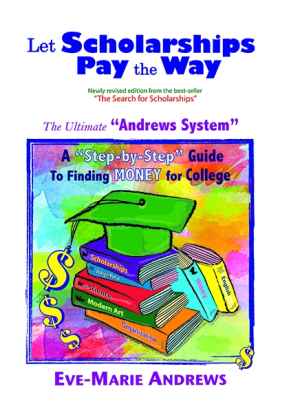
Let Scholarships Pay the Way
Andrews provides hope for prospective undergraduate and graduate students who fear the current cost of education.
In this helpful book, Let Scholarships Pay the Way, college counselor Eve-Marie Andrews offers advice on how to secure scholarships for undergraduate and graduate studies.
As a nontraditional student, Andrews completed several college degrees, including a master’s. She quickly realized that she had accrued $20,000 of debt during the process. Andrews secured a part-time college teaching position, lived frugally, and made slow and steady payments. Determined to help future college students avoid being saddled with similar financial burdens, she became interested in searching for scholarships; she eventually created a course, Scholarships 101, designed to help students locate, apply for, and receive funds for college. The tips Andrews has shared in her class over the years are provided in this resourceful book.
The book opens with an introduction to “The Andrews Scholarship System,” which instructs users to compile a three-ring binder of materials (e.g., calendar for deadlines, personal statement, and birth certificate) needed to efficiently apply for scholarships. Each section of the binder is described, complete with a checklist to ensure all elements are included. Time-honored suggestions are given, such as requesting letters of recommendation in a polite manner, keeping a résumé current by updating it regularly, and managing time and money wisely by being cognizant of how you spend both. Web addresses for the best sites offering information about scholarships (e.g., scholarships.com and zinch.com) are accompanied by brief summaries of the services provided. Lists of scholarships arranged around a wide array of needs and interests conclude the book: scholarships for women, military service members, ex-convicts, and immigrants, including undocumented individuals.
Let Scholarships Pay the Way would be more effective if the order of the two key sections were reversed. Readers are more likely to be motivated to develop an extensive portfolio once they have been convinced there are scholarships for which they qualify. While organizing materials in one place is great advice, the binder method seems outdated and should probably be replaced with directions on how to develop the portfolio using a cloud storage service (e.g., Dropbox or Google Drive). The intended audience is unclear because of references to a scholarship class instructor, information unique to Californians, and instruction on how to write a letter of recommendation. Andrews has clearly done significant research, and she indicates that information given is taken directly from various sources and compiled here. Spot illustrations of a finger pointing and an occasional dollar sign are bland, but the lists, boxed-in text, and clear and sparse writing are perfect for skimming and scanning.
Andrews posits that applying for two scholarships a week is ideal, and will likely increase the possibility of winning enough money to completely cover tuition. Testimonials from individuals who have successfully used her ideas offer hope and proof that during a time when undergraduate and graduate students across the country are questioning the value of a costly college education, others have actually discovered how to let scholarships pay the way.
Reviewed by
Kaavonia Hinton
Disclosure: This article is not an endorsement, but a review. The publisher of this book provided free copies of the book and paid a small fee to have their book reviewed by a professional reviewer. Foreword Reviews and Clarion Reviews make no guarantee that the publisher will receive a positive review. Foreword Magazine, Inc. is disclosing this in accordance with the Federal Trade Commission’s 16 CFR, Part 255.
